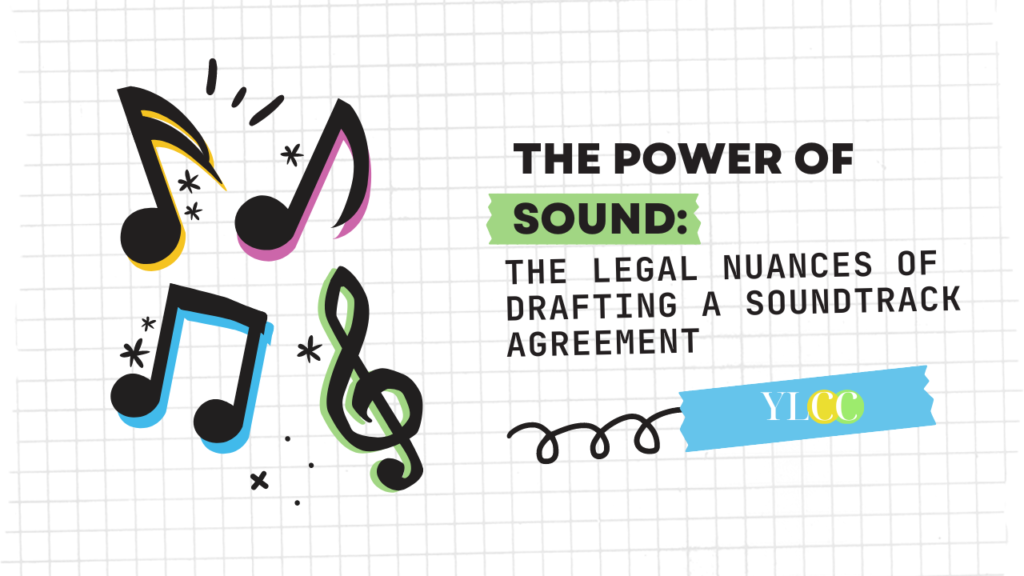
Introduction
A Soundtrack Agreement is a legal contract that governs the use of music or sound recordings about visual media such as films, television shows, video games, advertisements, and other audiovisual productions. This agreement establishes the terms and conditions under which the musical compositions or sound recordings will be incorporated into the visual work. This agreement specifies the rights granted by the music rights holder to the producer of the visual work. This may include exclusive or non-exclusive rights and the scope of usage (e.g., use in a film, TV show, online streaming, etc.).
The salience of auditory elements within the domain of visual media constitutes an important aspect that profoundly influences the viewer’s emotional engagement and narrative comprehension. The symbiotic relationship between sound and image underscores the need for an examination of the legal parameters governing the utilization of sound in audiovisual productions.
Team YLCC is here to provide you with a comprehensive exploration of soundtrack agreements, herein, aim to represent the contractual frameworks that underpin the incorporation of musical compositions into visual works. The drafting of soundtrack agreements necessitates an exacting level of legal precision to mitigate potential disputes and ambiguities. The inherent intellectual property law, coupled with the dynamic nature of the entertainment industry, underscores the imperative for attention to detail.
Key Components of a Soundtrack Agreement
A. Grant of Rights
- Exclusive vs. Non-Exclusive Rights: In stipulating whether the granted rights are exclusive or non-exclusive, the agreement establishes the level of exclusivity afforded to the contracting parties. Exclusive rights confer sole usage privileges to the producer, preventing the music rights holder from licensing the same music to other entities. Non-exclusive rights, on the other hand, allow the rights holder to license the music to multiple parties simultaneously.
- Scope of Usage (Film, TV, Streaming, etc.): The agreement precisely defines the permissible applications of the music within the visual work. This may include its incorporation in films, television broadcasts, online streaming platforms, advertisements, or any other specified medium. Clarity in the scope of usage is essential for avoiding ambiguity and potential disputes over the intended utilization of the music.
B. Compensation and Royalties
- Upfront Fees: The determination of upfront fees involves an evaluation of the music’s importance and prominence within the visual work. These fees serve as the initial compensation to the music rights holder upon execution of the agreement, reflecting the value attributed to the licensed music and compensating the rights holder for its immediate use.
- Performance Royalties: Performance royalties ensure ongoing compensation for the music rights holder when the visual work is publicly performed or broadcast. This provision is especially relevant for television broadcasts, public screenings, or any other form of public dissemination. Clear delineation of the calculation method and reporting mechanisms is crucial to facilitate accurate royalty payments.
- Back-End Participation: Back-end participation mechanisms address the rightsholder’s stake in the financial success of the visual work. This often involves a percentage-based participation in revenues generated beyond the upfront fees. Such arrangements align the interests of both parties, fostering a collaborative approach and incentivizing the creation of successful visual content.

C. Duration and Territory
- Term of Agreement: The term of the agreement establishes the duration during which the music rights are granted to the producer. It may be a fixed period or tied to specific events, such as the completion of the visual work. Additionally, provisions for renewal or extension may be included to accommodate potential sequels, adaptations, or subsequent usage.
- Geographic Restrictions: Geographic restrictions dictate where the visual work, featuring the licensed music, can be distributed or broadcasted. These restrictions safeguard the rights holder’s control over the geographical reach of their music, thereby, ensuring compliance with regional licensing laws and protecting the exclusivity of the granted rights.
D. Intellectual Property Rights
- Copyright Considerations: The agreement focuses on copyright considerations to ascertain the ownership and usage rights of the music. It represents the specific rights granted, such as reproduction, distribution, public performance, and adaptation, while navigating the legal landscape of copyright law. Clear identification of the copyright holder and the scope of licensed rights helps prevent inadvertent infringements and establishes a lawful foundation for the incorporation of music into the visual work.
- Original Compositions vs. Pre-Existing Music: The distinction between original compositions and pre-existing music is crucial in determining the rights and clearances required. Original compositions are works created specifically for the visual work, often commissioned from composers. Pre-existing music refers to music that already exists and may be owned by third parties. The agreement must stipulate whether the music is an original creation, ensuring clarity on the ownership of the composition, or if it involves pre-existing music, outlining the necessary permissions and clearances required for its use.
E. Representations and Warranties
- Assurance of Ownership and Authority: The section about the assurance of ownership and authority establishes a critical foundation for the agreement. The music rights holder provides explicit representations that affirm their legal ownership of the music and their authority to agree. This includes confirming that they possess the necessary rights to license the music for the intended usage in the visual work. Such assurances are fundamental for ensuring that the producer can confidently and lawfully incorporate the music without risking infringement claims.
- Non-Infringement: The non-infringement provision addresses the commitment of the music rights holder to warrant that the use of the licensed music within the visual work will not infringe upon the intellectual property rights of any third party. This includes copyrights, trademarks, or any other proprietary rights. The rights holder’s assertion of non-infringement is a crucial protection for the producer, shielding them from legal liabilities arising from potential intellectual property disputes.
- Indemnification for Breach: The indemnification clause establishes a mechanism for resolving issues arising from breaches of representations and warranties. If any representation made by the music rights holder is found to be untrue, the indemnification provision outlines the responsibilities and liabilities of the rights holder. This may involve compensating the producer for damages incurred due to the breach, covering legal expenses, or taking corrective actions to rectify the infringement. The indemnification for breach serves as a crucial risk mitigation measure, thereby, ensuring that the producer is protected in the event of legal challenges arising from the use of the licensed music.
Special Considerations for Emerging Platforms
- Soundtrack Agreements for Virtual Reality (VR) and Augmented Reality (AR): The advent of Virtual Reality (VR) and Augmented Reality (AR) introduces novel dimensions to the audiovisual landscape, necessitating specialized considerations within the realm of soundtrack agreements. This section addresses the unique challenges and opportunities posed by these immersive technologies. It states how music will be experienced within virtual and augmented environments, including considerations such as spatial audio, interactive elements, and the seamless integration of music with the user’s experience. Special licensing terms and rights allocations may be required to account for the distinct nature of these emerging platforms, thereby, ensuring that the soundtrack enhances rather than disrupts the immersive user experience.
- Impact of Evolving Technologies on Contractual Provisions: The rapid evolution of technology continually reshapes the landscape of audiovisual production. This subsection explores how emerging technologies, such as artificial intelligence, machine learning, and dynamic content delivery systems, impact contractual provisions within soundtrack agreements. It addresses considerations related to adaptive music systems, personalized user experiences, and the potential for technology-driven alterations to the original music. Provisions related to technological adaptations, updates, and the preservation of artistic intent become paramount, requiring a forward-looking approach to ensure that the agreement remains relevant and effective in the face of technological advancements.
Conclusion
As the entertainment industry continues its evolution, the future of soundtrack agreements stands at the intersection of technological innovation, creative expression, and legal acumen. The emergence of virtual and augmented reality, coupled with advancements in adaptive technologies, propels the necessity for agreements that not only reflect the current state of the industry but also anticipate and accommodate future developments. Soundtrack agreements are poised to become increasingly nuanced, adaptable, and responsive to the evolving needs of creators, distributors, and consumers alike. The integration of artificial intelligence, data-driven insights, and personalized experiences will likely reshape compensation models and usage parameters, thereby demanding a continuous reevaluation of contractual provisions to align with the changing dynamics of the entertainment landscape.
A well-drafted soundtrack agreement serves not only as a legal contract but as a dynamic instrument that orchestrates the collaborative symphony between music and visual media. Through a balance of legal precision, creative freedom, and technological foresight, the future of soundtrack agreements holds the promise of elevating the audiovisual experience while safeguarding the rights and interests of all stakeholders involved in this intricate dance of sound and vision.
Disclaimer: This article is for information purposes only. You are advised to consult a legal professional for drafting such crucial documents for your business.
This article has been written by Team YLCC. For any other queries, reach out to us at: queries.ylcc@gmail.com




